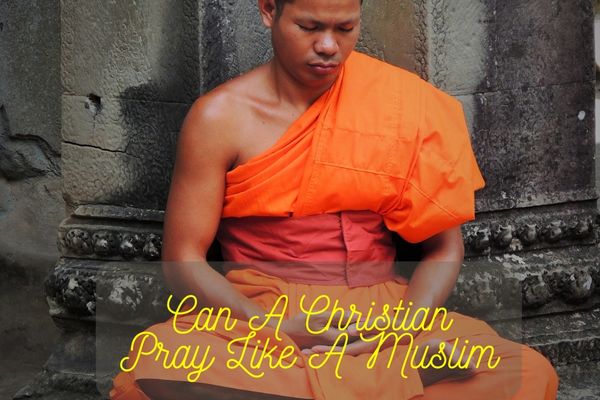Table of Contents Show
Christians and Muslims engage in prayer as a foundational element, shaping their relationship with the divine and guiding their spiritual journeys. This article embarks on a degreed exploration of a compelling question: “Can a Christian pray like a Muslim?”
Join us as we explore the sacred spaces of Christian and Muslim prayers, where tradition meets transcendence, and where the echoes of devotion resonate across diverse landscapes. In examining the intricacies of prayer, we seek not only to answer whether a Christian can pray like a Muslim but to unveil the profound beauty that emerges when these distinct paths intersect in the shared pursuit of a higher connection.
Can A Christian Pray Like A Muslim
Understanding Christian Prayer
Christian prayer, a deeply ingrained aspect of religious devotion, is a multifaceted practice that embraces a rich diversity of forms. This diversity reflects the individual and communal expressions of believers seeking to connect with the divine.
Spontaneous Prayer: One significant form of Christian prayer is spontaneous prayer. This form allows believers to communicate with God in an unscripted, personal manner. It is a moment of direct and sincere conversation where individuals express their thoughts, concerns, and gratitude to the Almighty. The emphasis here lies on the authenticity of the believer’s emotions and the desire for an intimate connection with God.
Liturgical Prayer: Another prominent form is liturgical prayer, often conducted within a formal religious service. Liturgical prayers are structured and follow a predetermined format, emphasizing the communal aspect of worship. Believers engage in collective expressions of praise, thanksgiving, confession, and supplication, creating a shared spiritual experience within the congregation.
Contemplative Prayer: Christian prayer also extends to contemplative forms, where individuals seek a profound connection with the divine through meditation and reflection. Contemplative prayer involves moments of stillness and silence, allowing believers to listen to the whispers of the divine and deepen their spiritual awareness.
The sincerity of the heart is a common thread that runs through all forms of Christian prayer. Believers are encouraged to approach prayer with genuine emotions, seeking not just a routine act but a personal relationship with the divine.
Exploring Muslim Prayer
In Islam, the practice of prayer, known as Salah, is a fundamental and ritualistic cornerstone of daily worship. Salah is a carefully choreographed series of physical postures and recitations, creating a unique and disciplined form of communication with the divine.
Physical Postures: The physicality of Salah involves specific postures, each carrying symbolic significance. The act of standing, bowing, and prostrating is not merely a set of movements but a holistic engagement of the body in the act of worship. This physical discipline is a manifestation of the believer’s submission to God, reinforcing a sense of humility and devotion.
Recitations: The recitations during Salah are integral to the prayer experience. Verses from the Quran are recited, emphasizing the divine revelations and reinforcing the spiritual connection between the worshipper and God.
Discipline and Mindfulness: The repetition of Salah throughout the day serves as a constant reminder of God’s presence, fostering discipline and mindfulness in the practitioner. It becomes a rhythmic and regular act that punctuates the daily routine, grounding the believer in their faith and reinforcing a continuous awareness of their relationship with the divine.
Muslim prayer, with its structured physical movements and recitations, is a testament to the disciplined and mindful approach to worship within Islam.
Comparing the Approaches
The divergence in practices does not diminish the fundamental similarities that underscore both Christian and Muslim prayer.
1. Intentions Behind Prayer: At their core, both Christian and Muslim prayers share the intention of seeking closeness to the divine. Whether through the spontaneous, diverse expressions of Christian prayer or the disciplined, ritualistic approach of Muslim prayer, believers from both traditions seek to establish a connection with God.
2. Emphasis on Humility: Both traditions place a strong emphasis on humility in the presence of the divine. Christian prayers often include expressions of humility, acknowledging human fallibility and the need for divine guidance. Similarly, the physical postures of Muslim prayer, especially the act of prostration, symbolise the ultimate humility before God.
3. Gratitude and Recognition: Christian and Muslim prayers both involve expressions of gratitude and recognition of a higher power. Christians express thanksgiving for blessings received, seek forgiveness through confession, and offer supplications for guidance. Similarly, Muslim prayers incorporate gratitude and acknowledgement of God’s sovereignty and mercy.
FAQs
1. Can Christians and Muslims pray together?
- Yes, individuals from different faiths can engage in respectful and inclusive prayer experiences, fostering mutual understanding.
2. Do Christians and Muslims believe in the same God?
- While there are theological differences, both faiths worship the monotheistic God of Abraham.
3. How can interfaith prayer benefit communities?
- Interfaith prayer promotes tolerance, unity, and a sense of shared humanity, contributing to peaceful coexistence.








